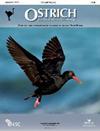How citizen scientists are rapidly generating big distribution data: lessons from the Arewa Atlas Team, Nigerian Bird Atlas Project
IF 1.1
4区 生物学
Q2 ORNITHOLOGY
引用次数: 2
Abstract
The Arewa Atlas Team (AAT) in northern Nigeria has set an example for a robust methodological data collection and made a big impact for the African Bird Atlas Project. To broaden national bird atlas projects and coverage across the continent, this paper reports on the activities and protocols of the AAT. We set out how we have galvanised bird clubs and bird club members to participate in this important monitoring project. We then focus on a bird atlas expedition conducted to the Bauchi State as an example. The outing was carried out from 24 to 28 September 2020 in line with the BirdMap protocol. For the first time, the AAT atlased 100 pentads and recorded 8 591 individual birds of 222 species (24.21% of Nigerian birds) from 67 families. We explore what can be done with these data, by presenting a summary of descriptions of the birds observed. For instance, we recorded 184 resident species, nine intra-African and 24 Palearctic migrants. The highest bird abundance (120 individuals) was recorded at 11°00′26.9″ N, 9°29′46.5″ E, pentad 1105C0925. Furthermore, the Rock Firefinch Lagonosticta sanguinodorsalis was out-of-range from Lumba. The Tawny Eagle Aquila rapax (Vulnerable) and Pallid Harrier Circus macrourus (Near Threatened) were species of conservation concern. Results of this survey shows that citizen science is a powerful tool to make rapid biodiversity assessments of bird species richness and abundance and provides insights into bird occurrence and composition. This can be extended to distribution over time at a local geographic scale. Continuous efforts to map bird distributions are therefore recommended, mostly in regions and countries where atlas projects have not been established or still in the formative stages. It is important that bird atlas teams maximise ways to accomplish more noteworthy coverage in their respective national bird atlas projects and here we outline how we accomplished this as motivation and a model for the African Bird Atlas Project.公民科学家如何快速生成大分布数据:来自Arewa Atlas团队、尼日利亚鸟类地图集项目的经验
尼日利亚北部的Arewa地图集小组(AAT)为强有力的数据收集方法树立了榜样,并对非洲鸟类地图集项目产生了重大影响。为了扩大国家鸟类地图集项目和覆盖范围,本文报告了AAT的活动和协议。我们阐述了如何激励鸟类俱乐部和鸟类俱乐部成员参与这一重要的监测项目。然后,我们以在包奇州进行的鸟类地图集考察为例。根据鸟图协议,郊游于2020年9月24日至28日进行。AAT首次采集到67科222种8 591只鸟(占尼日利亚鸟类的24.21%)。我们通过对观察到的鸟类的描述进行总结,探索如何利用这些数据。例如,我们记录了184种常驻物种,9种非洲内部物种和24种古北移物种。在北纬11°00′26.9″,东经9°29′46.5″,候号1105C0925,鸟类数量最多,达120只。此外,岩火雀Lagonosticta sanguinodorsalis不在Lumba的范围内。褐鹰(易危)和白鹞(近危)是需要保护的物种。调查结果表明,公民科学是快速评估鸟类物种丰富度和丰度的有力工具,有助于了解鸟类的发生和组成。这可以扩展到在当地地理范围内随时间的分布。因此,建议继续努力绘制鸟类分布图,主要是在尚未建立地图集项目或仍处于形成阶段的区域和国家。重要的是,鸟类图集团队在各自的国家鸟类图集项目中最大限度地实现更值得注意的覆盖,在这里我们概述了我们如何实现这一目标,作为非洲鸟类图集项目的动力和模型。
本文章由计算机程序翻译,如有差异,请以英文原文为准。
求助全文
约1分钟内获得全文
求助全文
来源期刊

Ostrich
生物-鸟类学
CiteScore
2.10
自引率
30.00%
发文量
24
审稿时长
>12 weeks
期刊介绍:
Ostrich: Journal of African Ornithology is the leading ornithological journal in Africa, and publishes peer-reviewed scientific papers and short communications (
 求助内容:
求助内容: 应助结果提醒方式:
应助结果提醒方式:


